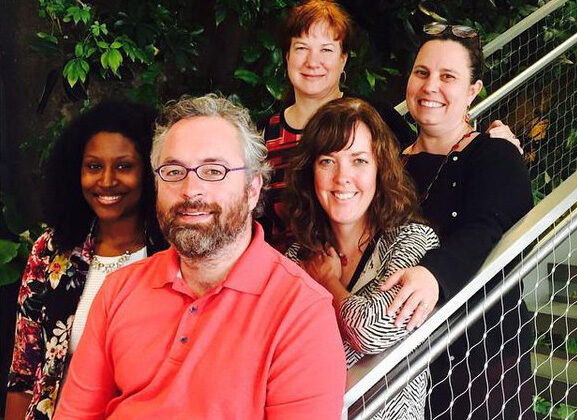
I’ve been to a lot of trainings in my life, even since I “retired” from teaching in a classroom. The sad fact is that most of them were bad, enough that I remember the good ones to this day.
The reason for this badness varied (every unhappy family is after all alike in its own way) but a common thread was how many of them embodied this quote from John Dewey:
“That education is not an affair of ‘telling’ and being told, but an active and constructive process, is a principle almost as generally violated in practice as conceded in theory.”
That pretty much sums up all of the lectures I attended where I was lectured about not lecturing.
When I began working with Ennis Carter at the start of Public Image Works 2015, I knew the series was not going to be like that. But what was it going to be like? Would it clear the very low bar set by my previous experiences?
Of course, I am writing from the future — on Back to the Future Day no less — so I know that Public Image Works is not just good, but amazing, and if you have attended you know it too.
But why was it so amazing? A quick list.
1) The space created. For the trainings that met in the Dodge Foundation offices, a modern masterpiece of environmental design with a real live waterfall, that was easily done. But even in the more office park type environment of Monroe Township, a real working space was created, and it was important that it was a face-to-face, instant creative hub. It is probably possible to create that sort of community online and remotely, but much more difficult. We weren’t just staring blankly at each other, we were doing the joyous work of relationship building.
2) It actually works. All of the material presented had enough flexibility for organizations to really make it work if they implemented it. It was the right balance of established and innovation. A lot of trainings I attended have been either too faddish, too hidebound, or worse yet both!
3) We do the actual work, too. We made plenty of space for work to get done in the room, assigned lots (but not too lots?) of homework, but I think as important was that we use all the worksheets and templates in our actual work at Social Impact Studios, and continued to do so as the series unfolded. We were following the fundamental law of teaching or maybe just of being human, not asking anyone to do anything that you weren’t willing to do yourself and it really enlivened our material. As a new employee, it helped me learn on the ground.
Doing actual work that works, in a place together, that we do ourselves all adds up to:
A real learning community. Because ultimately, that’s how humans learn — not from books or videos but from each other.
So know that we know why Public Image Works works, it’s worth thinking of why it doesn’t work, or rather what is keeping it from translating into real change? I learned way back in high school science class is that a good theory predicts when it will fail.
Public Image Works will definitely fail if you aren’t able to manage it all, which is why we added that as a crucial stage. Also, if you are trying to do things without the elements I have identified above (place, actual work, practicing what you preach), you will probably fail us.
Managing It All isn’t just about making sure you complete your homework or schedule a “Just in Time” session with us, though of course you should do both those things! It’s more about a willingness to identify the real obstacles to being able to communicate and create your Public Image.
I recently got a new title: Catalyst Director. As cofacilitator Laura Steffen taught us, a catalyst is an ingredient that sparks a reaction without itself being consumed. In my work, I am looking to find out what why both we and clients sometimes fall short, and what kind of catalyst we need to get to the next step.
In a way, failure is a much better teacher than victory.
Share in the comments:
How can we continue working together as reflective practictioners to find how we could do the real mission work that is Public Image?
Pictured at top: The Public Impact Works facilitator crew at the final workshop this summer.
Jesse Bacon is Catalyst Director at Social Impact Studios and one of the facilitators from the organization to lead Public Image Works, a Dodge Technical Assistance series designed to help good groups get the attention their important missions demand.
About Social Impact Studios Since 1996, the people at Social Impact Studios have combined artistry & activism to promote important social issues. We believe good causes should get more attention than anything else. And we believe thoughtful, beautiful and meaningful communication is still the best way to engage and motivate people. Social Impact Studios is a creative hub where groups and creative activists collaborate, learn and do the work. From concept to creation, we design action plans, visuals, messages and moving grassroots experiences that make a social impact – together.

